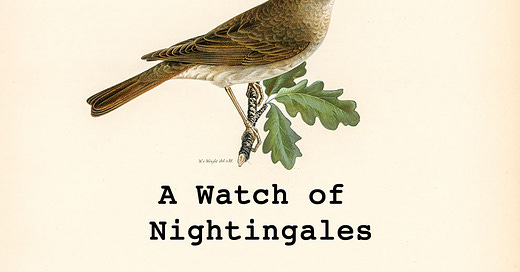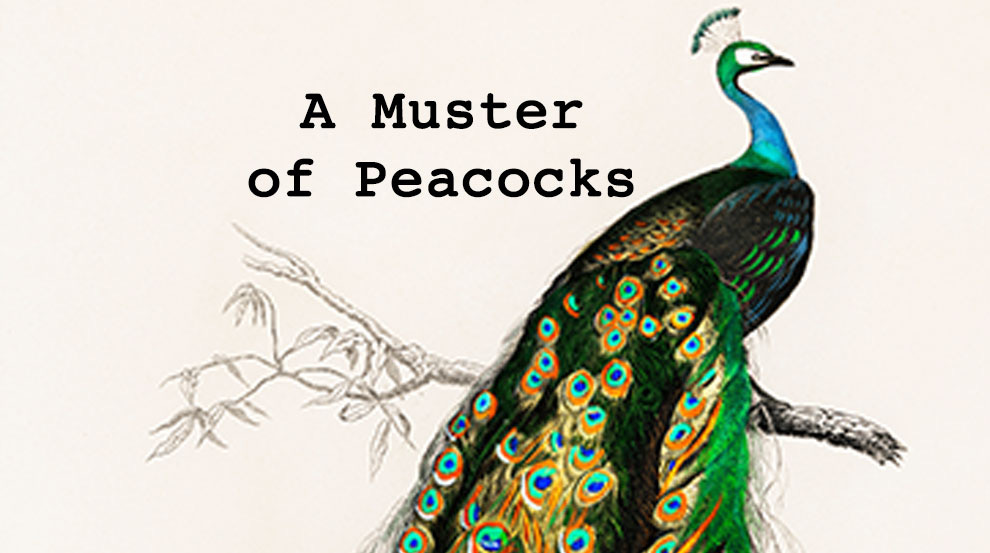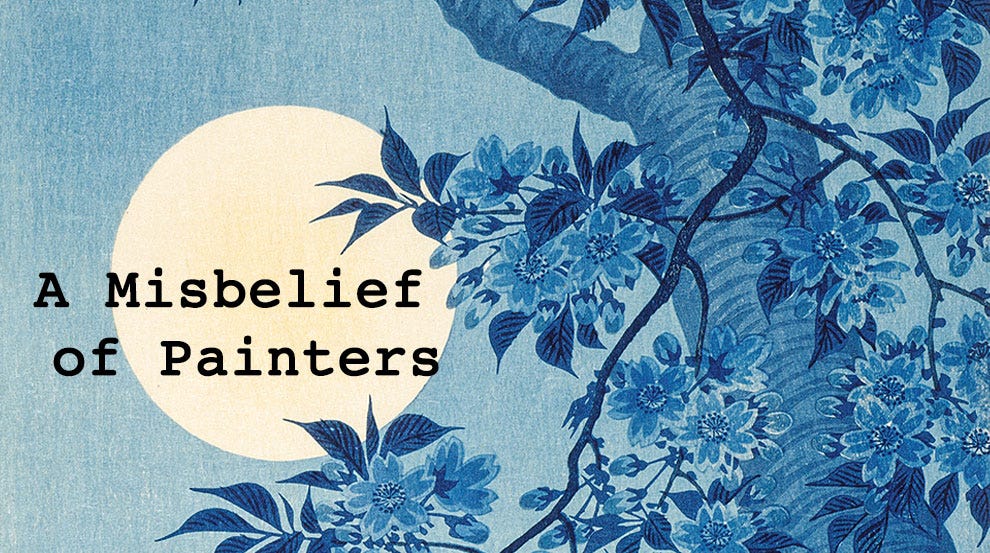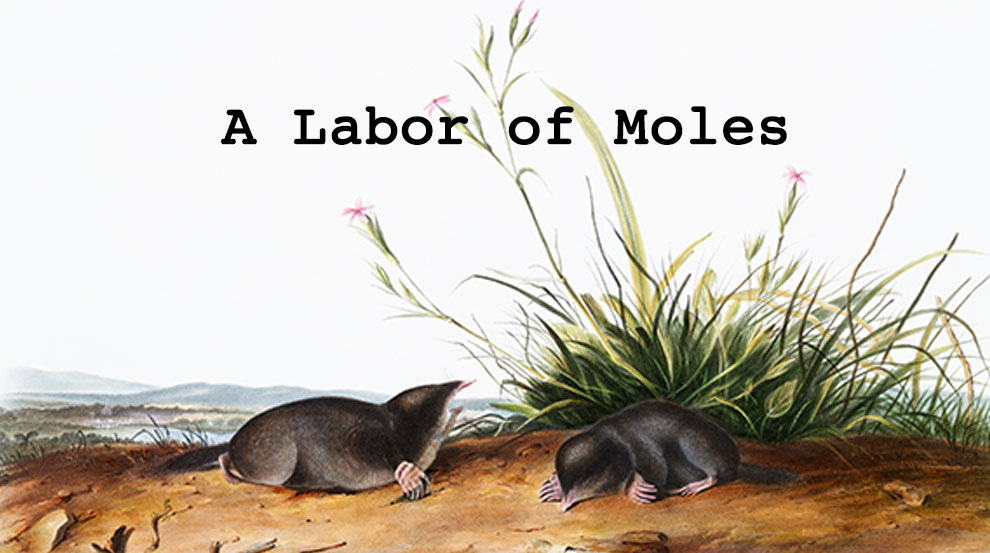A Watch of Nightingales: The Origin Story of Collective Terms for Animals
Plus, some truly delightful collective terms for people, from a “rascal of boys” to a “superfluity of nuns.”
At the bottom of a breathtakingly dull late 15th century manuscript entitled Grammatica, the exhausted scribe (who signs his name Wulrey de Plecy1) has left us a little rhyming note unrelated to the text itself:
Nunc scripsi totum pro christo da mihi potum.
Now that I’ve written all of this, for Christ’s sake give me a drink.
There is something rather magical about how this little aside makes the alienating distance of 500 years disappear in an instant. How the sudden intrusion of pique and humor cuts right through the ages and the unfamiliar language to make a human connection.2 And it makes me think in particular of another oft-quoted Medieval artifact from the same era — the odd little compendium that’s one of our earliest sources for the “terms of venery,” the extensive group of collective nouns for animals whose playfulness and inventiveness comes alive again each time they’re rediscovered.
Plenty of these collective nouns are commonplace (or at least familiar) today: Swarm of bees, gaggle of geese, pack of hounds, pride of lions, flock of sheep, flight of swallows, and even murder of crows and murmuration of starlings are unlikely to raise much of an eyebrow. But as accustomed as we are to schools3 of fish and herds of deer, the wit and invention that went into these classifications comes right back into view when you encounter one that’s more or less fallen out of the language, such as exaltation of larks, or paddling of ducks, or unkindness of ravens. As James Lipton (the guy from Inside the Actors’ Studio, who is, weirdly, one of the main reasons these words haven’t faded into obscurity) says in his book on the subject:
“What we have in these terms is clearly the end result of a game that amateur philologists have been playing for over five hundred years.”
And I think he’s put his finger on the same thing that made me associate the terms of venery with the relatable grumbling of poor old Wulrey de Plecy. History, and language, have a weight to them that makes a construction like pride of lions feel authoritative, natural, inevitable. But when you see it in context, alongside shrewdness of apes, skulk of foxes, or business of flies — as well as the equivalent terms for groups of people, such as hastiness of cooks, promise of bartenders, or (wonderfully) incredulity of cuckolds — it comes roaring back to life not just as a fanciful piece of terminology, but as a playful invention whose creators were in on the joke.
The key text here is The Book of St. Albans, a 1486 manuscript that is likely a compilation from various different sources, but which is attributed to Dame Juliana Barnes,4 making her one of the earliest English women to get a byline. The Book of St. Albans is a “courtesy book,” a “manual of conduct for a considerable number of people who longed to know how to conduct themselves in a changing world,” as Marjorie Gray Wynne, the rare books librarian at Yale where a copy of the manuscript is housed described it. Oddly enough, Arthur Conan Doyle (on a break from Sherlock Holmes in 1906) included a lengthy scene in his novel Sir Nigel imagining how a young knight might receive instruction on the terms of venery contained in such a book:
“The old Knight shook his white head doubtfully. “There is so much to be learned that there is no one who can be said to know all,” said he. “For example, Nigel, it is sooth that for every collection of beasts of the forest, and for every gathering of birds of the air, there is their own private name so that none may be confused with another.”
Although it’s not the earliest book of this sort to contain nouns of assembly (or “gatherations” as they’re sometimes rather nicely called), The Book of St. Albans is the most extensive, with 164 separate collective nouns for animals, people, and objects ranging in kind from onomatopoeic (a peep of chicks, a clattering of choughs) to descriptive (a trip of hares, a leap of leopards, an eloquence of lawyers) to ominous (a tiding of magpies, a damnation of jurors) to straight-up mean (an intoxication of cobblers, a worthlessness of jugglers, an abominable sight of monks,5 and an impatience of wives).
There have been a number of worthy additions to the corpus since 1486 (my personal favorite is an unemployment of graduates,6 though C.S. Lewis’s parliament of owls has by far the best claim for actual adoption in the language), but there’s a wealth of lovely old ones to be found in the original manuscripts. For my part, now that I’ve written all of this — for Christ’s sake give me a drink.
I normally don’t dwell on these things, but I need you to know that the lengths I went to in order to track down this poor soul and give him some credit were … considerable. A version of the quote resurfaces in English every now and then thanks to a collection of Medieval marginalia published awhile back by Lapham’s Quarterly, but I feel quite strongly that if your little bit of workplace gallows humor stands the test of time to the tune of 500-odd years, people should at least know your name. Anyway, rest in peace, Wulrey de Plecy. I hope you got that drink.
I should note that this was a fairly common practice for scribes, who often added a “colophon” (meaning “finishing touch”) at the end of what was by all accounts an extremely grueling process. Most of them asked readers to pray for their poor hands.
This is more likely in the sense of “shoal” (as in “multitude,” and, infuriatingly, apparently unrelated to “shoal” as in “shallows”) than it is a metaphor suggesting a group of students, but it’s proving too complicated for me to try and completely untangle here.
What’s not debated is that her signature is on the document, somewhere in the middle, so it’s likely that she was a person and that she did write some of it, but you know how scholars can get about this sort of thing.
“An Abominable Sight of Monks” really stands out here as an oddity, but John Hodgkins (whose 1909 “Attempt at a Rational Explanation of the Meanings of the Collection of Phrases in ‘The Book of St. Albans” is one of the most important pieces of scholarship on the topic) calls it “no sarcastic allusion, but the plain belief bluntly stated.” People just didn’t like monks very much.
Per Lipton, C.E. Hare singles this one out as a contemporary coinage in his 1949 book on the topic, The Language of Field Sports.








I would like to add to the list with “a lot of car salesmen.” Or saleswomen.
I'd be interested in an explanation of the use of "venery" in this context. My dictionary defines venery as "sexual indulgence" or, archaic, as "hunting." What is the missing link from there to gatherations?
In the early oughts, I submitted a group noun to a call-out for such and ended up being mentioned in the follow-up. My contribution -- a dump of spam -- is apparently buried beneath that dump, which has since become both an avalanche of spam and a bankruptcy of spam.
Love your substack.